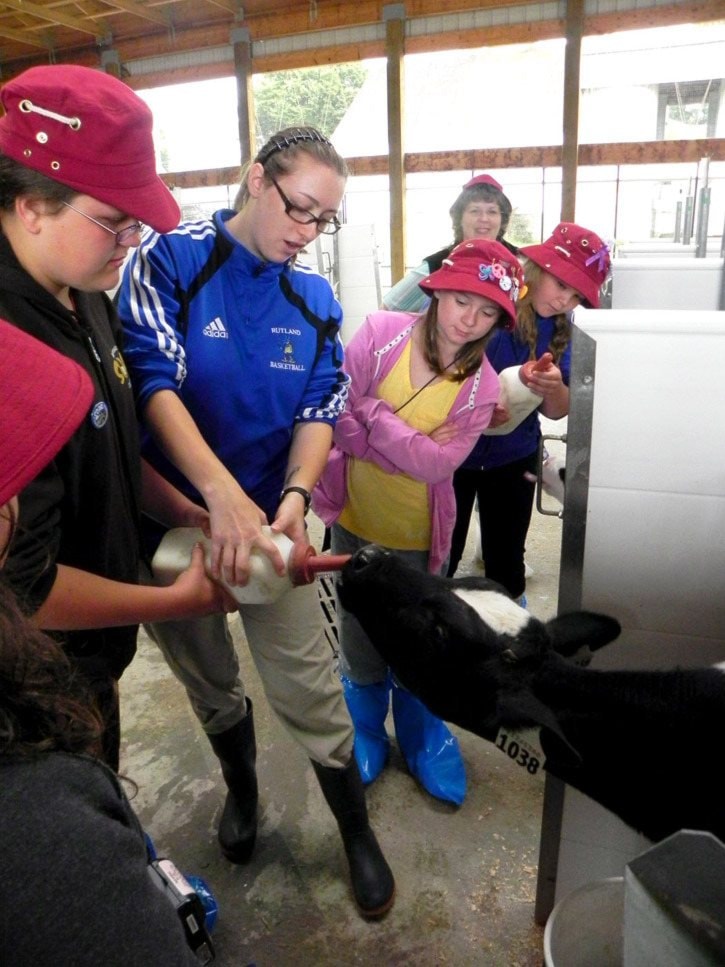Calf number 1073 snores dreamily in the corner of her stall at the UBC Dairy Research Centre. Her hair is unkempt, curly and wet. Her front legs are tucked under its body, which is rising and falling with each breath. She curls up more and falls into an even deeper sleep, completely ignoring the gaggle of girls watching her from outside the stall.
Weighing in at a healthy 37 kilograms, this little black and white creature is the newest calf on the working dairy farm. She's only 12 hours old. And for that, she gets the biggest oohs and ahhs from a small group of Girl Guides and their leaders. They toured through the centre Tuesday morning as part of Dairy Divas, a program designed specifically to draw in Guides while they were in Agassiz for the SOAR camp this week. Tours were held throughout the week, drawing in about 100 of the 1,400 Guides and Pathfinders staying in town this week. Dairy Divas was just one of the many programs girls could sign up for.
"Awww... She's not even a day old," one girl sighs.
They all wonder why the baby isn't mooing, calling for milk like the calves in the other pens.
Their tour guide, a student working at the dairy centre, explains that she already fed the calf four litres of milk in the middle of the night. That's a lot of milk for a brand new calf, and she's sleeping off the splurge.
"She's pretty full," she tells the girls, who pull out their cameras to capture images of the young, sleepy heifer. They move on to another row of individual pens, where the cows are wide awake, a few days older, and definitely hungry. Then, the girls are given milk bottles equipped with plastic 'udders', to carry out the best job of all — feeding two of the heifers, Henrietta and Gummy Bear.
The pair eats greedily, pushing their faces against the bottles, spilling milk, and jumping with joy. The girls laugh.
"I'm so happy I took Dairy Divas now," says Alexa Davis, a member of the 2nd Cloveridge Guides.
For Alexis Roscoe, from the Ruby Creek #36 troop in Surrey, feeding calves is a thrill, but nothing new.
"They always have calves in the barn at the PNE," she says, and kids can feed them during demonstrations throughout the fair.
But the whole feeding process begs the question from the group — where are the babies' moms? And they learn that the answer —that all the calves are separated from their mother's shortly after birth — is a fact of life on dairy farms. It's easier on both mother and calf, and gives the calves a cleaner environment to live in.
But it's not the end of the mother and calf bond. That utmost important mother's milk, colostrum, is still fed to the calves for the first few feedings of their lives. Calves aren't born with the immune system that humans have, and colostrum is loaded with potentially life-saving antibodies.
And because they need to measure the amount of colostrum a calf is getting, they milk the mothers and feed the cows pasteurized milk.
Measuring milk intact is just one of the many jobs at UBC's WestGen Calf Research Centre. Here, they're not just breeding cows for the purpose of producing milk. They're breeding for science discovery, with the goal of improving both the dairy industry and the general health of cattle. And this is what the Guides are visiting the Research Centre to learn.
They measure cow behavior, running various test experiments to see how small changes affect the cow's moods. Do the cattle enjoy being indoors or out, for example. Do they prefer to have birthing rooms, or birthing in their pens. How often are they lying down? When do they sleep?
For their part, the Guides had to answer their own set of research questions, such as 'if you were a cow, what would you like to have in your pen with you?'
And when they were done in the barn, the Guides moved onto the classroom to learn about calcium — the great dairy connection.
Registered dietician Rola Zahr spoke to the girls about the importance of dairy products, or fortified soy products, to improve and maintain bone health. And the day ended with a treat, a yogurt smoothie made with raspberries grown next door at the Pacific Agricultural Research Centre.
Guides getting around town
It would be impossible to miss the Girl Guides as they visited Agassiz and the surrounding area this week. Their colourful hats covered with pins, and tradable goods have been seen all over town, and in communities across the Fraser Valley and Vancouver area. While many of the girls were out on information scavenger hunts, learning about Agassiz, there have also been a number of service projects going on.
Each Guide was given the task of completing 2.5 hours of community service, and for some that meant packing up school supplies to be delivered to local families. On Saturday night, the group paraded through Agassiz, displaying their banners from around the world before heading back to their camp at Centennial Park for an opening ceremony that included Mayor Lorne Fisher, Harrison's Mayor Ken Becotte and Chilliwack's Mayor Sharon Gaetz.
The night ended with a performance by Victoria Duffield, a young Abbotsford singer who has performed on YTV's The Next Star.
The Guides' closing ceremony will be held tonight at Centennial Park before the campers head back home.
Linda Fairley, public relations for SOAR 2011, said that although there are no Guiding groups in Agassiz, Harrison Hot Springs or Hope, they are hoping someone locally will step forward to volunteer and create a group.
SOAR is held every three years, in communities around the province. Fairley says Agassiz is the "most urban" location they've chosen to date, offering a variety of new opportunities to the Guides, such as the parade.
news@ahobserver.com
